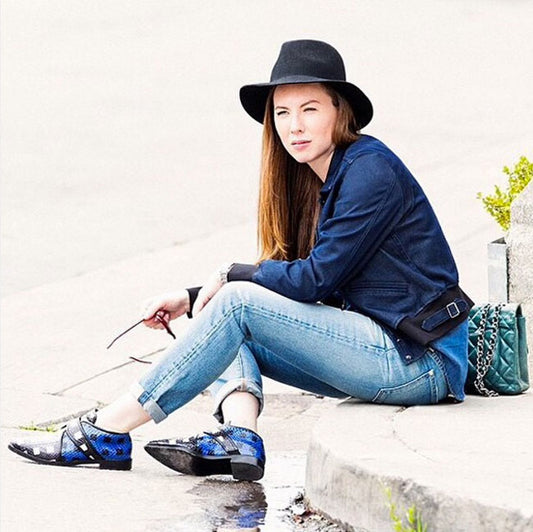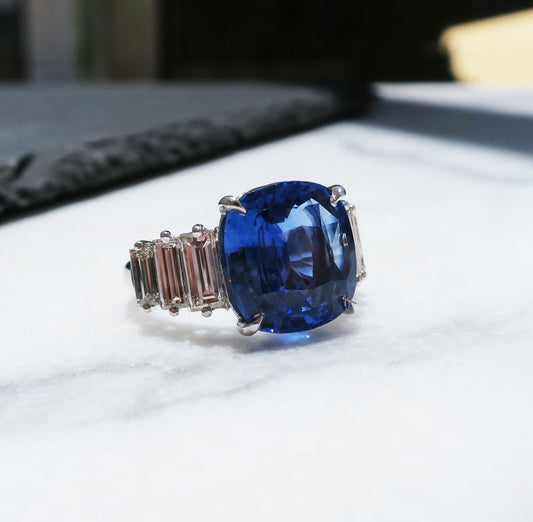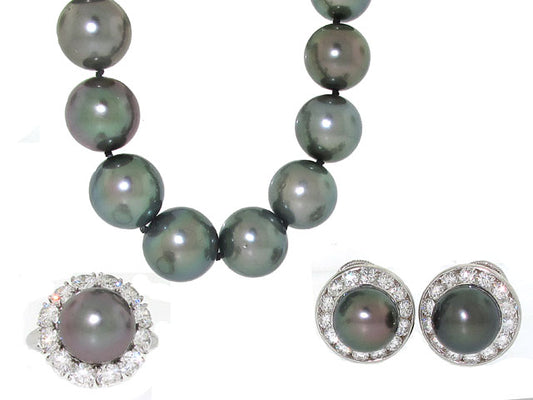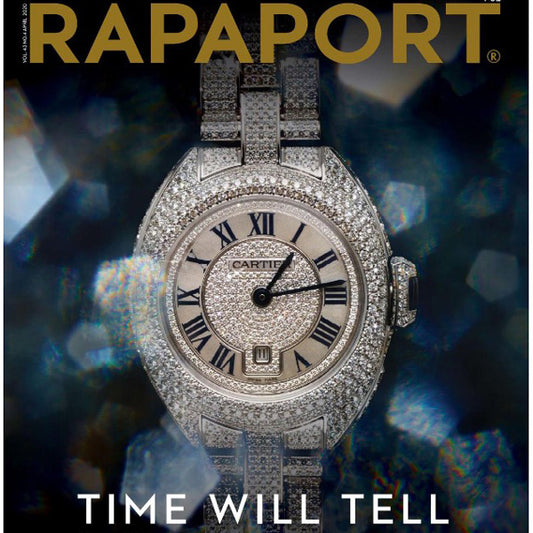The Georgian period of jewelry design coincided with a time of radical political upheaval in Europe and North America. Spanning the years from 1714 through 1837, the Georgian period is named for the reigns of the four British King Georges, I through IV. At the beginning of the period, precious jewelry was mainly worn by the upper echelons of society, primarily royalty. Long, dangling gemstone and diamond chandelier earrings and short necklace styles such as graduated diamond riviere necklaces and diamond and gemstone chokers complemented the low-cut necklines and upswept hairstyles in fashion. Old mine cut diamonds and colored gemstones were placed a jour, in open-backed settings that allowed light to illuminate the stones, though stones such as garnets were still set in traditional foil-back settings. Women also wore diamond and gemstone brooches, pins and pendants designed in girandole and pendeloque styles, single or trios of gemstone drops suspended by intricate center designs. Also developed during this time was paste, facilitating the creation of imitation jewelry designs for those unable to afford precious material. Early Georgian jewelry tended to be large and dramatic in scale and design so as to not be overpowered by the sweeping dresses and towering hairstyles in fashion.
At the turn of the century, women’s fashions changed dramatically from large sweeping gowns to empire-waist dresses with short sleeves and low necklines. This style of dress was inspired by Europe’s fascination with ancient Greek and Roman culture. Like the style of dress, jewelry design was also inspired by those ancient civilizations. Gold chain eslavage necklaces were worn with drop earrings. Other popular turn-of-the-century Georgian jewelry designs include micro mosaics while carved cameos were increasingly worn, several strung on a chain or ribbon.
Several decades later, women’s fashions transformed again, with tight bodices and billowing sleeves replacing the Grecian style of dress. Metalsmiths developed intricate designs using twisted gold wire cannetille filigree in foliate designs accented with delicate granulation designed to maximize the visual impact of an amount of gold. Women often wore matching jewelry suites of bracelets, necklaces, earrings, brooches and pendants called parures.
THE ART AND THE HISTORY
GEORGIAN JEWELRY
The Georgian Period 1714-1837
While it was a period of significant historical events, including the reigns of Catherine the Great of Russia, Louis XVI of France, as well as the American Revolution, the French Revolution, and the Napoleonic Wars, it was also a time when some of the most beautiful art, fashion and jewelry was created.

Portrait of Catherine the Great of Russia with Girandole Earrings and Brooch
The late Georgian Period also corresponded with the onset of the Industrial Revolution and many scientific innovations and discoveries were made which affected the design and manufacturing of jewelry. Amongst these innovations were the setting of diamonds and colored gemstones a jour, meaning open backed, allowing light to pass through rather than being foil backed; the development of cannetille filigree using rolled gold wires and granulation, or beaded gold work; the invention of paste or jewels made of faceted glass; and the invention of pinchbeck, a gold type metal made from copper and zinc. Important discoveries included amethysts in the Urals and the metal platinum although it wouldn’t be used for jewelry until the late Victorian /early Edwardian eras.

Portrait of Mary Edwards with Pearl Necklace with Bow and Cross Pendants, Chatelain and Gold Rings
Baroque, Neo-Classical and early Romantic styles influenced fashion and jewelry design. This influence can be seen in 18th and early 19th Century portraiture of the prominent women of the era such as Catherine the Great of Russia, Madame Pompadour, Mary Edwards, Hortense de Beauharnais, and Countess Daru.
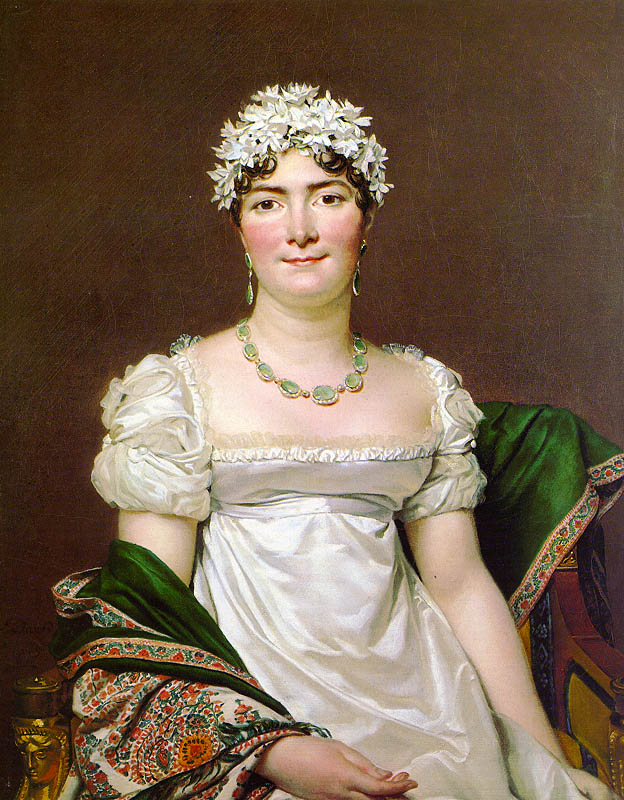
Portrait of Countess Daru with Riviere Necklace and Pendeloque Earrings
Popular jewelry styles included the girandole which was used in brooches, pendants and earrings. The girandole style was composed of three hanging pendants set with single or multiple stones hanging from a center stone. Georgian girandole jewlery was often embellished with bows. Another common style of the period was the pendoloque which was composed of a marquise diamond set top suspending a bow from which falls a marquise or pear shaped drop.

Portrait of Neo-Classical Lady with Pearl Ear Pendants and Pearl Hair Ornament
Another key style of the time was the riviere, a necklace with individually set stones of the same size or graduating to a larger size in the front. A riviere could be worn alone or with a pendant attached. Often a riviere was part of a parure which is a suite or set of matching jewelry including a necklace, earrings, bracelet and brooch.
The elaborate fashions of Marie Antoinette and the French Court, consisting of corset-waisted dresses with full panniers and skirts, deep decolletage and three quarter sleeves, demanded jewelry of a scale that was large enough so as not to be overpowered by the silks, taffetas and laces of the richly embellished dresses. Magnificent parures of old mine cut diamonds or rock crystal and colored stones such as pink topaz, green chrysoberyl, and purple amethyst were preferred by women of means. Pearls were also fashionable, alone or mixed with foil backed gemstone jewelry. Hair ornaments such as diadems, aigrettes and tiaras complemented the complicated upswept hairstyles and wigs.

Portrait of a Lady with Coral Necklace
During the French Revolution, ostentatious jewelry was a detested sign of the old Regime. After the revolution when Napoleon came into power, Neo-Classicism came into style, and women’s fashions evolved to
feature empire waists, short sleeves, supple fabrics and soft draperie reminiscent of the fashions of Ancient Greece and Rome. This new style demanded lighter and more delicate jewelry or none at all, such as was seen in one of the most famous portraits of the era, Madame Recamier by David, who was shown, unadorned. When jewelry was worn, it consisted of necklaces and bracelets of delicate cannetille filigree or Classical inspired intaglios, cameos or gemstones in placque style, delicately suspended from swagged chains. These delicate swagged chain necklaces were known as esclavages or slave chains. Earrings changed from the girandole chandelier style to more subtle long drop ear pendants.

Portrait of Amelie Von Heine
As the Neo-Classical era gave way to the early Romantic era, dresses, while still high waisted, became more substantial with longer sleeves, pleated backs and other embellishments. Jewelry of this period also became more substantial with gemstone necklaces suspending gemstone cross pendants in different styles including Maltese crosses and cruciforms. Long gold chains and mourning jewelry featuring locks of hair in glass, often crafted as enclosed oblong or oval brooches were also coming into fashion – though they would not yet gain the popularity they would see during the Victorian era. The Romantic period marked the beginning of the Gothic Revival in art, literature, architecture and design. A feature of early Gothic Revival jewelry was the use of cut steel, Berlin iron and Silesian wire. These materials could be formed into lacy woven bracelets, necklaces and chatelains but the overall effect was darker and heavier than the late 18th Century and Neo-Classical jewelry.


